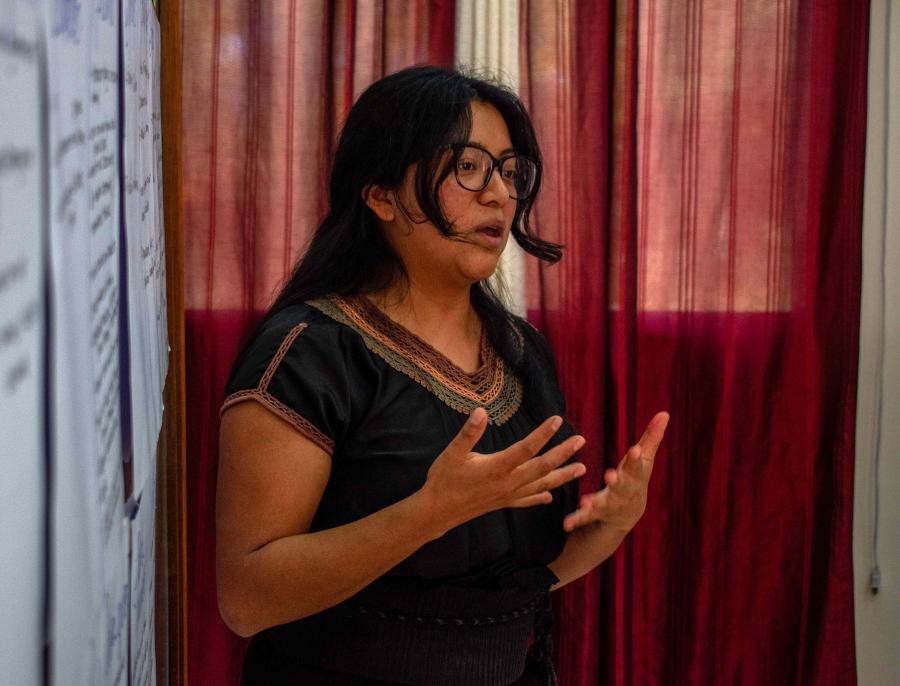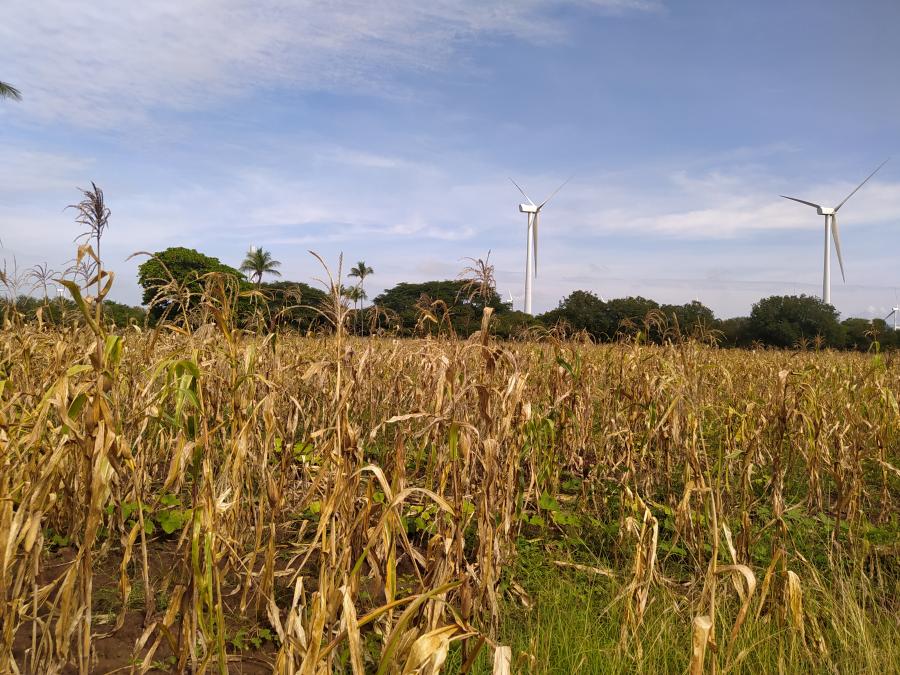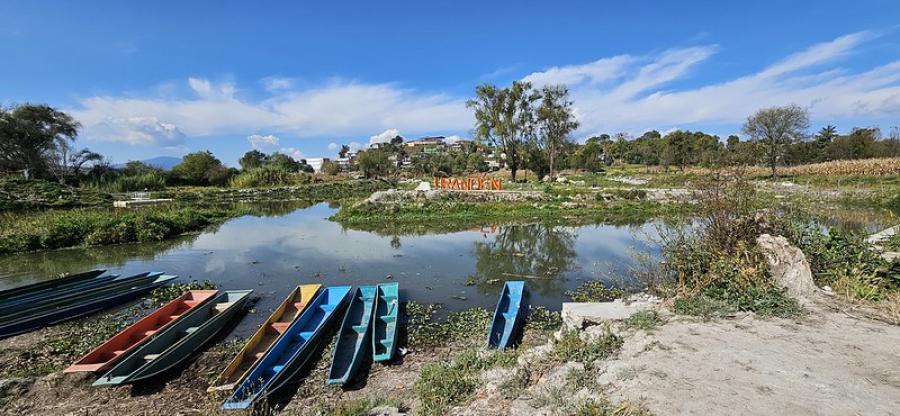Terralingua:
Partnerships for Linguistic and Biological Diversity
In June 2000, a unique gathering took place in Chihuahua City, the capital of the northern Mexican state of Chihuahua, through which runs the famed Sierra Tarahumara, part of Mexico's Sierra Madre Occidental. Indigenous Rarámuri (Tarahumara) and ...dami (Tepehuan) residents of the Sierra, as well as local Mestizos, met with a multidisciplinary group of researchers and practitioners to discuss the possible development of a binational (U.S.-Mexican) project. The project had two proposed aims: to document the biological, cultural, and linguistic diversity of the Sierra Tarahumara region, and to devise strategies to support the perpetuation of this diversity in the face of current large-scale commercial exploitation of the region's natural resources and a projected dramatic increase in tourism. A follow-up meeting was held in August 2000 in the Rarámuri community of Norogachi.
Links Between Biological, Cultural, and Linguistic Diversity
Less than a decade ago, such a meeting -- including local residents, biologists, conservationists, anthropologists, and linguists, and concerning the endangerment of biological, cultural, and linguistic diversity -- would have been unheard of. But in recent years it has been increasingly apparent that the extinction crisis affecting the world's biodiversity is closely related, in its causes and consequences, to the crisis threatening the world's indigenous and traditional peoples, their languages, and their cultural traditions.
In 1996, a group of scholars and indigenous representatives gathered in Berkeley, California for an international conference entitled "Endangered Languages, Endangered Knowledge, Endangered Environments." Participants agreed that the connections between the different manifestations of the diversity of life -- biological, cultural, and linguistic -- reside in the intimate link between language and knowledge, including traditional knowledge about the environment. Language, they argued, is central to people's ability to conceptualize and understand the world and to act on it. Human culture is a powerful adaptation tool, and language both enables and conveys much cultural behavior. And while language cannot express all knowledge, beliefs, and values, it does represent the main instrument by which people elaborate, develop, and transmit such ideas. Conference participants concluded that the processes leading to the disenfranchisement of indigenous and traditional peoples -- and to the replacement of their world views, ways of life, and languages with those of dominant groups -- are part and parcel of the processes leading to environmental deterioration and destruction. They called for further research and joint action to better understand these connections and to help stop and reverse these trends.(1)
Indigenous Languages as Part of Cultural Heritage
The Sierra Tarahumara Diversity Project, whose outlines emerged from the meetings between scholars and Sierra Tarahumara residents last summer, is squarely taking up that challenge. Project ideas are being discussed and elaborated jointly among indigenous and non-indigenous participants.(2) The protection of indigenous cultural heritage, including cultural traditions, languages, and environments, was stressed from the outset and highlighted as a key priority. The Rarámuri and ...dami expressed a clear concern about ongoing appropriation of their traditional knowledge, especially as regards medicinal plants. They also lamented the educational policies and socioeconomic factors promoting language shift (abandonment of the native languages in favor of Spanish) and the rejection of cultural traditions and indigenous identity among the younger generations.
Concern for the protection of indigenous knowledge, especially knowledge about the uses of natural resources, is not new. What has received less attention internationally is the need for integrated protection of indigenous languages. Indigenous peoples the world over have increasingly identified their languages -- along with traditional knowledge, beliefs, values, ritual, folklore, crafts, and biodiversity -- as part of their cultural heritage. They see their cultures and languages as intimately linked with their lands and territories. And they consider the maintenance and continued development of their languages as an integral part of their cultural vitality. If we heed these views and are interested in the protection of indigenous knowledge, then we should also be concerned about protection of indigenous languages.
Integrated protection of indigenous heritage is unlikely to come exclusively from intellectual property rights (IPR). What protection IPR systems afford to indigenous cultural heritage is meant to shield indigenous peoples against misappropriation, abuse, and misuse of their heritage. But IPR alone will not shield indigenous peoples from erosion of their heritage. Protection against this erosion must be the ultimate goal, lest we witness the disappearance of the very cultural traditions whose expressions are protected by IPR. Indigenous peoples and others have repeatedly expressed the conviction that, ultimately, a sui generis (new and specific) legal system must be implemented for the adequate protection of indigenous peoples' rights. Some hope is offered by the emerging (if as yet uneasy and fragile) confluence of different bodies of international law (human rights, labor rights, environmental protection, IPR, cultural heritage protection) around issues concerning the rights of indigenous peoples.
Recent Processes and Mechanisms for the Protection of Indigenous Heritage
The only legally binding international instruments entirely devoted to the rights of indigenous peoples is the 1989 International Labor Organization (ILO) Convention on Indigenous and Tribal Peoples no. 169. ILO 169 upholds indigenous and tribal peoples' right to recognition and retention of customary law and practices, with special reference to control over land and resources and collective land ownership. It also contains provisions concerning the maintenance and development of indigenous and tribal identities, traditions, values, and languages. With only 14 signatories so far, however, its ability to support indigenous and tribal peoples' rights internationally is limited.
Also relevant is the 1992 Convention on Biological Diversity (CBD), especially Articles 8j, 10c, and 18.4.
These articles are concerned with the respect, preservation and promotion of "knowledge, innovations and practices of indigenous and local communities embodying traditional lifestyles relevant for the conservation and sustainable use of biological diversity" (Art. 8j). They also deal with establishing appropriate agreements for the development and utilization of such "knowledge, innovations and practices" and the equitable sharing of benefits deriving from this utilization. The CBD has been signed by 177 countries, and thus has the potential to become an important tool for the protection of the specific indigenous rights it covers. Indigenous peoples are actively participating in the implementation process being conducted by the Conference of the parties to the CBD. The protection of indigenous languages as linked to that of traditional knowledge has become a topic in this process.
The most comprehensive and advanced international document produced so far for the protection of indigenous peoples' rights, including key aspects related to indigenous knowledge and languages, is the Draft UN Declaration on the Rights of Indigenous Peoples. The UN Working Group on Indigenous Populations (WGIP) completed its elaboration in 1994 through extensive consultation with indigenous representatives from around the world. The Declaration is currently under examination by the UN Sub-Commission on the Prevention of Discrimination and the Protection of Minorities, and efforts are under way for a final version to be approved and adopted by the UN General Assembly before the end of the Decade of Indigenous Peoples in 2004. Although as a declaration (rather than a convention or agreement) it would form part of non-legally-binding "soft law," it could represent a very influential international standard. Approval of the Declaration in its present form seems unlikely, however, because of opposition by many Member States to recognition of indigenous peoples' rights, self-determination in particular.
Since 1998, activities relevant to indigenous peoples' rights have also been undertaken by the World Intellectual Property Organization (WIPO), the specialized UN agency in charge of the development, revision, harmonization, and application of international norms and standards on intellectual property rights (IPR). WIPO has held two Round Tables (in 1998 and 1999) with representatives of Member States, indigenous peoples, and non-governmental organizations (NGOs), and has carried out a series of fact-finding missions, pilot projects, and studies on traditional knowledge and its protection. Whether these activities will lead to an evolution of the IPR system to meet the special needs of indigenous peoples for the protection of their traditional knowledge is uncertain. Some Member States aim to restrict the scope of such protection to a purely economic context, especially in terms of issues relevant to the World Trade Organization (WTO) and its Trade-Related Aspects of Intellectual Property Rights agreement (TRIPs).(3)
Both language and cultural heritage issues fall under the specific mandate of UNESCO (the UN Educational, Scientific and Cultural Organization). Concerning language, a Draft Universal Declaration of Linguistic Rights, an NGO initiative, was handed over to UNESCO in 1996. It was the first, if imperfect, attempt to provide a comprehensive universal codification of linguistic human rights, both individual and collective. At that time, the Draft was viewed unfavorably by a majority of UNESCO Member States. Recently, however, UNESCO has issued statements to the effect that linguistic rights are high on its agenda, while renewed NGO efforts are under way to promote the revision and approval of the Declaration.
In addition, UNESCO has long been concerned with the protection and preservation of "world" cultural heritage, tangible and intangible. As regards intangible heritage, the 1989 UNESCO Recommendation on the Safeguarding of Traditional Culture and Folklore considers folklore as part of the universal heritage of humanity. A "global assessment" of this Recommendation, now with a focus on "Local Empowerment and International Cooperation," was carried out by UNESCO in June 1999 in collaboration with the Smithsonian Institution (see also Berman, Seitel and McCann in this issue). On issues of folklore, UNESCO also collaborates with WIPO. The two organizations presided over the development of the 1982 Model Provisions for National Laws on the Protection of Folklore Against Illicit Exploitation and Other Prejudicial Actions, and in 1997 jointly held the World Forum on the Protection of Folklore. These instruments do not specifically refer to language, but it is evident that language is central to many aspects of folklore, and it might thus be argued that protection of the world's languages is an intrinsic part of the protection of the world's folkloric patrimony.
Cultural and Linguistic Rights as Human Rights
UNESCO has now begun to move toward consideration of cultural heritage issues as they relate to cultural rights, including those of indigenous peoples. UNESCO's Culture Sector has on its agenda the protection of cultural rights (including linguistic rights) as human rights. In its 1995 report, Our Creative Diversity, UNESCO's World Commission on Culture and Development (WCCD) treats cultural rights as collective rights -- rights which refer to the freedom of "a group of people to follow or adopt a way of life of their choice." Furthermore, it points out that this is a freedom which "by protecting alternative ways of living encourages creativity, experimentation and diversity, the very essentials of human development." A working group created with UNESCO's support has elaborated a Draft Declaration of Cultural Rights as a basis for UNESCO's further work on theoretical and normative development of cultural rights.
In the context of protection of indigenous peoples' heritage rights, cultural rights deserve greater attention than they have so far been accorded. This lack of attention is not surprising. Cultural rights are the least well developed of the fundamental human rights recognized in the Universal Declaration of Human Rights and spelled out in the 1966 International Covenant on Civil and Political Rights (ICCPR) and International Covenant on Economic, Social, and Cultural Rights (ICESCR). The two Covenants make only modest (if legally binding) provisions concerning cultural rights. ICESCR refers to the rights of "everyone," which, in the terminology of international rights instruments, are individual rights. As the ICCPR article spells out in the case of minorities, however, it is evident that participation in cultural life is only possible within a collective dimension.
The tension between the individual and collective dimensions of cultural rights and the question of whether and under what circumstances collective rights might override individual rights are only two of the unresolved issues that have hampered the development of cultural rights. One pragmatic reason for this underdevelopment is actually shared by cultural, social, and economic rights as compared to civil and political rights. Civil and political rights are negative rights (they require states to refrain from certain actions). Economic, social, and cultural rights, on the other hand, are positive rights (they require states to take a proactive role involving funds, time, and processes). This disparity implies a qualitative difference in states' obligations vis-à-vis implementation of these two sets of rights. Many states have simply been reluctant to take up such positive obligations and to stand up to international scrutiny with regard to the application of these rights.
Other unresolved issues have to do with age-old dilemmas, such as the very definition of "culture." The ICESCR and ICCPR articles clearly oscillate between different concepts of culture: culture as the highest intellectual and artistic achievements of a group; culture as the process of scientific and artistic creation; and culture in the more anthropological sense, as a total way of life (a system of knowledge, beliefs, values, and practices -- the material and spiritual activities and products of such activities -- by which a group distinguishes itself from others). In addition, the intrinsically dynamic character of culture poses problems in terms of firmly defining the content of cultural rights. Another dilemma is whether cultural rights do have a universal dimension or are culture-specific, and whether international standards for cultural rights can be developed while respecting cultural diversity.
Recognizing Cultural Rights (and Obligations)
Addressing these dilemmas can contribute -- crucially -- to enhancing the universality of human rights by rooting them in different cultural traditions. The development of cultural rights might also play a major role in the creation of an overall integrated framework and sui generis system for the protection of indigenous peoples' rights. The Vienna Declaration and Programme of Action adopted by the 1993 World Conference on Human Rights explicitly called for a "concerted effort to ensure recognition of economic, social, and cultural rights," while also advocating action to ensure "the full and free participation of indigenous people in all aspects of society, in particular in matters of concern to them." The protection of indigenous languages and knowledge, as well as of other aspects of cultural heritage, naturally falls under the rubric of cultural rights. Both the integrity and the dynamic nature of cultural heritage might find recognition in this context, and many of the relevant international instruments and processes might be further elaborated and harmonized. In spite of many obstacles, international processes may be opening up to the prospect of (to a large extent) morally defined indigenous heritage rights, according to a global ethics built on respect for cultural diversity and distinct worldviews.
Working toward the establishment of a more general framework for the protection of indigenous heritage might also offer an opportunity for deeper cross-cultural reflection on the nature of knowledge, and of the quest for knowledge, as well as on the relationships between rights and duties. It has often been noted that for indigenous peoples not knowledge per se but rather wisdom may be a goal. And in discussing the Western discourse of "rights," legal scholar Lyndel Prott has asked whether thinking in terms of rights is our only, let alone our best, option. She observes: "Many traditional communities think in terms of the obligations of the human community to earth and the other species on it. Perhaps the idea may be the beginning of a new normative framework for the preservation of heritage."
For researchers and practitioners working in collaboration with indigenous peoples, such as those who are participating in the development of the Sierra Tarahumara Diversity Project, this sort of reflection is crucial, in terms of how to balance their customary freedom of inquiry and action with a newer recognition of different views about knowledge and of their ethical obligations toward other humans and the environment. To their local counterparts, such as the Rarámuri and ...dami of the Sierra Tarahumara, this reflection should bring ever greater appreciation of and respect for their unique contributions to the tapestry of humanity, as well as tools and support for the protection of their cultural (and natural) heritage.
Acknowledgements
The author is grateful to Graham Dutfield, Dave Harmon, William Merrill, Darrell Posey, Mary Riley, and Tove Skutnabb-Kangas for their insightful and helpful comments and suggestions on an earlier version of this article.
References & further readings
Daes, E.I. (1997). Protection of the Heritage of Indigenous People. Study Series 10, Human Rights. New York/Geneva: United Nations.
Greaves, T.C. (1995). Cultural rights and ethnography. General Anthropology 1:2, pp 1, 3-6.
Harmon, D. (1996). Losing species, losing languages: Connections between biological and linguistic diversity. Southwest Journal of Linguistics 15, pp 89-108.
Maffi, L., ed. (In press). On Biocultural Diversity: Linking Language, Knowledge, and the Environment. Washington, D.C.: Smithsonian Institution Press.
Nie..., H., ed. (1998). Cultural Rights and Wrongs. Paris/Leicester: UNESCO Publishing/ Institute of Art and Law.
Posey, D.A., ed. (1999). Cultural and Spiritual Values of Biodiversity. London/Nairobi: Intermediate Technology Publications/UNEP.
Skutnabb-Kangas, T. (2000). Linguistic Genocide in Education -- Or Worldwide Diversity And Human Rights? Mahwah, N.J.: Lawrence Erlbaum.
UNESCO (1998). World Culture Report: Culture, Creativity and Markets. Paris: UNESCO Publishing.
WCCD 1998 (1995). Our Creative Diversity. Report of the World Commission on Culture and Development. Paperback edition. Paris/Leicester, UK: UNESCO Publishing/Oxford and IBH Publishing.
WWF International and Terralingua (2000). Indigenous and Traditional Peoples of the World and Ecoregion-Based Conservation: An Integrated Approach to Conserving the World's Biological and Cultural Diversity. Gland, Switzerland: WWF International.
(1). Additional information about the conference can be found at ucjeps.berkeley.edu/Endangered_Lang_Conf/Endangered_Lang.html.
(2). No concrete project planning had occurred beforehand, except for exploratory steps suggesting a coincidence of interests between local people and external researchers and practitioners.
(3). Relevant WIPO documents can be found at http://www.wipo.int/tk/en/tk/
Article copyright Cultural Survival, Inc.



